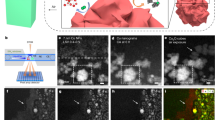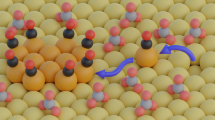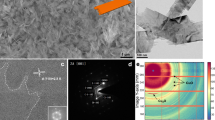Abstract
Cu catalyzes the electrochemical reduction of CO2 or CO to an assortment of products, a behavior that is a detriment when only one reduced compound is desired. The present article provides an example in which, through the atomic-level control of the structure of the Cu electrode surface, the yield distribution is regulated to generate only one product. The reaction investigated was the preferential reduction of CO to C2H5OH on Cu at a low overpotential in alkaline solution. Experimental measurements combined electrochemical scanning tunneling microscopy (ECSTM) and differential electrochemical mass spectrometry (DEMS). An atomically ordered Cu(100) surface, prepared from either a single crystal or by Cu(pc)-to-Cu(100) reconstruction, did not produce ethanol. When the surfaces were subjected to monolayer-limited Cu↔Cu2O cycles, only the reconstructed surface underwent an additional structural transformation that spawned the selective production of ethanol at a potential 645 mV lower than that which generates multiple products. Quasi-operando ECSTM indicated transformation to an ordered stepped surface, Cu(S) − [3(100) × (111)], or Cu(511). The non-selective, multiple-product Cu-catalyzed reduction of CO had thus been regulated to yield only one liquid fuel by an atomic-level structural modification of the electrode surface.

TOC GRAPHIC






Similar content being viewed by others
Notes
Other aspects investigated, such as the use of non-aqueous solvent, the employment of reactant concentrators, the influence of electrolyte, the adoption of gas-phase-feed approaches, or the method of product analysis, are deemed not of fundamental significance since those do not alter the free-energy landscape of the electrocatalytic reaction.
Cu is a prodigious scavenger of O2(g); hence, ex situ characterization of an electrode not stringently protected from the environment will invariably encounter several surface layers of Cu2O and CuO [23].
The appreciable cathodic evolution of H2 and the reduction of CO at −1.06 V (SHE) precluded the atomic resolution of the ECSTM images. Hence, the ECSTM experiments at slightly less negative potentials (−0.9 V) to ensure minimal catalytic activities, cannot be rigorously classified as true operando.
It cannot be overemphasized that, whereas the ECSTM images displayed in this paper are only for nanometer-scale domains on the bulk crystal, those are representative of the entire surface because numerous images have been evaluated throughout the macroscopic surface. The protocol has always been that results will be adopted only if satisfactory agreement exists among all the sampled images.
It is not understood at this time, but it is beyond the scope of the present paper, why an ordered Cu(100) layer situated at the top of a Cu(pc) substrate is more pliable than a Cu(100) sheet above a Cu(100) base. It is likely related to the adhesion of various surfaces in contact with one another. For example, the adhesion coefficient of Cu(100)-Cu(100) planes has been reported to be five times larger than that for Cu(111)-Cu(100) surfaces [35].
References
Y. Hori, Electrochemical CO2 reduction on metal electrodes, in Modern Aspects of Electrochemistry, ed. by C.G. Vayenas, R.E. White, M.E. Gamboa-Aldeco (Springer, New York, 2008), p. 89
M. Gattrell, N. Gupta, A. Co, A review of the aqueous electrochemical reduction of CO2 to hydrocarbons at copper. J Electroanal Chem 594, 1 (2006)
D.T. Whipple, P.J.A. Kenis, Prospects of CO2 utilization via direct heterogeneous electrochemical reduction. J Phys Chem Lett 1, 3451 (2010)
K.J.P. Schouten, Y. Kwon, C.J.M. van der Ham, Z. Qin, M.T.M. Koper, A new mechanism for the selectivity to C1 and C2 species in the electrochemical reduction of carbon dioxide on copper electrodes. Chem Sci 2, 1902 (2011)
K.P. Kuhl, E.R. Cave, D.N. Abram, T.F. Jaramillo, New insights into the electrochemical reduction of carbon dioxide on metallic copper surfaces. Energy Environ Sci 5, 7050 (2012)
A. Javier, J.H. Baricuatro, Y.-G. Kim, M.P. Soriaga, Overlayer Au-on-W near-surface alloy for the selective electrochemical reduction of CO2 to methanol: empirical (DEMS) corroboration of a computational (DFT) prediction. Electrocatalysis 6, 493 (2015)
S. Back, H. Kim, Y. Jung, Selective heterogeneous CO2 electroreduction to methanol. ACS Catal 5, 965 (2015)
M. Karamad, V. Tripkovic, J. Rossmeisl, Intermetallic alloys as CO electroreduction catalysts—role of isolated active sites. ACS Catal 4, 2268 (2014)
K. Chan, C. Tsai, H.A. Hansen, J.K. Nørskov, Molybdenum sulfides and selenides as possible electrocatalysts for CO2 reduction. ChemCatChem 6, 1899 (2014)
J.H. Montoya, C. Shi, K. Chan, J.K. Nørskov, Theoretical insights into a CO dimerization mechanism in CO2 electroreduction. J Phys Chem Lett 6, 2032 (2015)
T. Cheng, H. Xiao, W.A. Goddard, Free-energy barriers and reaction mechanisms for the electrochemical reduction of CO on the Cu(100) surface, including multiple layers of explicit solvent at pH 0.J. Phys Chem Lett 6, 4767 (2015)
K.J.P. Schouten, Z. Qin, E.P. Gallent, M.T.M. Koper, Two pathways for the formation of ethylene in CO reduction on single-crystal copper electrodes. J Am Chem Soc 134, 9864 (2012)
F. Calle-Vallejo, M.T.M. Koper, Theoretical considerations on the electroreduction of CO to C2 species on Cu(100) electrodes. Angew Chem Int Ed 52, 7282 (2013)
Y.-G. Kim, J.H. Baricuatro, A. Javier, J.M. Gregoire, M.P. Soriaga, The evolution of the polycrystalline copper surface, first to Cu(111) and then to Cu(100), at a fixed CO2RR potential: A study by operando EC-STM. Langmuir 30, 15053 (2014)
E. Andrews, M. Ren, F. Wang, Z. Zhang, P. Sprunger, R. Kurtz, J. Flake, Electrochemical reduction of CO2 at Cu nanocluster/(100) ZnO electrodes. J Electrochem Soc 160, H841 (2013)
D. Kim, J. Resasco, Y. Yu, A.M. Asiri, P. Yang, Synergistic geometric and electronic effects for electrochemical reduction of carbon dioxide using gold-copper bimetallic nanoparticles. Nat Commun 5, 4948 (2014)
S. Zhu, M. Shao, Surface structure and composition effects on electrochemical reduction of carbon dioxide. J Solid State Electrochem 20, 861 (2015)
W. Tang, A.A. Peterson, A.S. Varela, Z.P. Jovanov, L. Bech, W.J. Durand, S. Dahl, J.K. Nørskov, I. Chorkendorff, The importance of surface morphology in controlling the selectivity of polycrystalline copper for CO2 electroreduction. Phys Chem Chem Phys 14, 76 (2012)
Y. Hori, I. Takahashi, O. Koga, N. Hoshi, Selective formation of C2 compounds from electrochemical reduction of CO2 at a series of copper single crystal electrodes. J Phys Chem B 106, 15 (2002)
Y. Hori, R. Takahashi, Y. Yoshinami, A. Murata, Electrochemical reduction of CO at a copper electrode. J Phys Chem B 101, 7075 (1997)
Y. Hori, A. Murata, R. Takahashi, S. Suzuki, Electroreduction of carbon monoxide to methane and ethylene at a copper electrode in aqueous solutions at ambient temperature and pressure. J Am Chem Soc 109, 5022 (1987)
A. Verdaguer-Casadevall, C.W. Li, T.P. Johansson, S.B. Scott, J.T. McKeown, M. Kumar, I.E.L. Stephens, M.W. Kanan, I. Chorkendorff, Probing the active surface sites for CO reduction on oxide-derived copper electrocatalysts. J Am Chem Soc 137, 9808 (2015)
Y.-G. Kim, M.P. Soriaga, Cathodic regeneration of a clean and ordered Cu(100)-(1 × 1) surface from an air-oxidized and disordered electrode: an operando STM study. J Electroanal Chem 734, 7 (2014)
Y. Hori, I. Takahashi, O. Koga, N. Hoshi, Electrochemical reduction of carbon dioxide at various series of copper single crystal electrodes. J Mol Catal A Chem 199, 39 (2003)
C.W. Li, J. Ciston, M.W. Kanan, Electroreduction of carbon monoxide to liquid fuel on oxide-derived nanocrystalline copper. Nature 508, 504 (2014)
R. Reske, H. Mistry, F. Behafarid, B. Roldan Cuenya, P. Strasser, Particle size effects in the catalytic electroreduction of CO2 on Cu nanoparticles. J Am Chem Soc 136, 6978 (2014)
R.A. van Santen, Complementary structure sensitive and insensitive catalytic relationships. Acc Chem Res 42, 57 (2009)
A. Javier, B. Chmielowiec, J. Sanabria-Chinchilla, Y.-G. Kim, J.H. Baricuatro, M.P. Soriaga, A DEMS study of the reduction of CO2, CO, and HCHO pre-adsorbed on Cu electrodes: empirical inferences on the CO2RR mechanism. Electrocatalysis 6, 127 (2015)
K. Itaya, In situ scanning tunneling microscopy in electrolyte solutions. Prog Surf Sci 58, 121 (1998)
I. Horcas, R. Fernández, J.M. Gomez-Rodriguez, J. Colchero, J. Gómez-Herrero, A.M. Baro, WSXM: a software for scanning probe microscopy and a tool for nanotechnology. Rev Sci Instrum 78, 013705 (2007)
T.V. Vorburger, Methods for Characterizing Surface Topography, in: Tutorials in Optics, ed. by D.T. Moore (Optical Society of America, Washington, DC, 1992), p. 137
H. Baltruschat, Differential Electrochemical Mass Spectrometry as a Tool for Interfacial Studies, in: Interfacial Electrochemistry, ed. by A. Wieckowski (Marcel Dekker, New York, 1999), p. 577
H. Baltruschat, Differential electrochemical mass spectrometry. J Am Soc Mass Spectrom 15, 1693 (2004)
R.W.G. Wyckoff, Crystal Structures, vol. 1, 2nd edn. (Wiley, New York, 1963)
D.H. Buckley, Surface Effects in Adhesion, Friction, Wear, and Lubrication (Elsevier, New York, 1981), p. 270
Acknowledgments
This material is based upon work performed by the Joint Center for Artificial Photosynthesis, a DOE Energy Innovation Hub, supported through the Office of Science of the U.S. Department of Energy under Award No. DE-SC0004993.
Author information
Authors and Affiliations
Corresponding author
Rights and permissions
About this article
Cite this article
Kim, YG., Javier, A., Baricuatro, J.H. et al. Regulating the Product Distribution of CO Reduction by the Atomic-Level Structural Modification of the Cu Electrode Surface. Electrocatalysis 7, 391–399 (2016). https://doi.org/10.1007/s12678-016-0314-1
Published:
Issue Date:
DOI: https://doi.org/10.1007/s12678-016-0314-1
Keywords
- Selective reduction of CO to ethanol on Cu(511) in alkaline solution at low overpotential
- Operando generation of Cu(511) electrode surface from polycrystalline Cu
- Operando electrochemical scanning tunneling microscopy (OECSTM)
- Differential electrochemical mass spectrometry (DEMS)
- Seriatim OECSTM-DEMS




